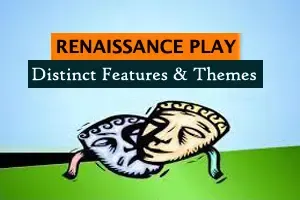Renaissance Play: Distinct Features and Themes
Q. What is a Renaissance play? Mention some of the distinct features of Renaissance play.
Answer: A Renaissance play is a type of theatrical production that was written and performed during the Renaissance period, which spanned roughly from the 14th to the 17th century in Europe. This era marked a significant cultural and artistic revival, and Renaissance plays were characterized by certain distinct features and themes:
Classical Influence: Renaissance playwrights drew inspiration from ancient Greek and Roman drama. They sought to revive classical traditions, including the use of Greek and Roman themes, structures, and literary forms. This influence can be seen in the use of classical plots, such as tragedies and comedies, and the adoption of classical forms like the five-act structure.
Humanism: Humanism, a key intellectual movement of the Renaissance, emphasized the importance of human experience, individualism, and human potential. Renaissance plays often explored the complexities of human nature, moral dilemmas, and the human condition. Characters were developed with greater depth and complexity, reflecting this humanistic focus.
Secular Themes: While medieval drama was often focused on religious and moralistic themes, Renaissance plays included a wider range of secular topics. These themes included love, politics, power, ambition, and the pursuit of knowledge.
Language and Style: Renaissance plays used more sophisticated and poetic language, with a strong emphasis on the beauty and eloquence of words. The use of blank verse (unrhymed iambic pentameter) became popular, allowing for a more natural and expressive form of dialogue. This innovation is particularly associated with playwrights like Christopher Marlowe and William Shakespeare.
Exploration of the Supernatural: The Renaissance was marked by a fascination with the supernatural, and this was often reflected in plays. Witches, ghosts, and magic were common elements in many Renaissance dramas, adding an element of mystery and intrigue.
Tragedy and Comedy: Renaissance plays often adhered to the classical distinction between tragedy and comedy. Tragedies explored the fall of a great individual due to a character flaw or external circumstances, while comedies typically featured lighter themes and a resolution that brought happiness and harmony.
Innovation in Theater: The Renaissance period saw advancements in theater technology and design. Elaborate stage designs, costumes, and the use of perspective in scenery were introduced. Playwrights also experimented with meta-theatrical elements, such as self-referential characters and themes about the nature of drama and illusion.
Social and Political Commentary: Many Renaissance plays contained allegorical or thinly veiled political and social commentary, reflecting the period's shifting power structures and concerns about authority. This was particularly evident in the works of playwrights like Ben Jonson and William Shakespeare.
Prominent Renaissance playwrights include William Shakespeare, Christopher Marlowe, Ben Jonson, John Webster, and Thomas Kyd, among others. Their works continue to be celebrated for their enduring themes, complex characters, and contributions to the development of modern theater.
*****
Read also:
👉 What is a Poetry? | Definition, Elements and Types
👉 What is a Lyric Poem? | Importance of Lyric Poems
👉 What is a Short Story? | Its features and significance
👉 What is a Narrative Poem? | Importance of Narrative Poems
👉 What is a Metaphysical poetry? | Explain its features
👉 What is Comic Relief? | What role does it play in literature?
👉 Common Figures of Speech | in English Literature
👉 Literary Terms related to Drama or Play | in English Literature
